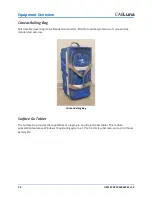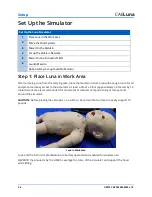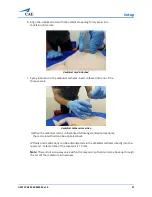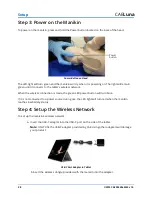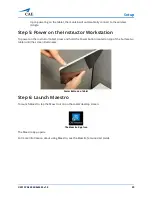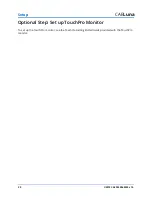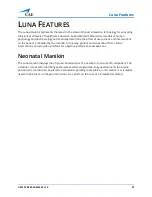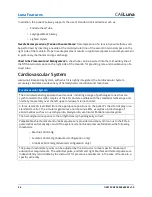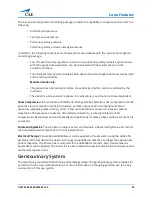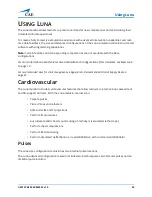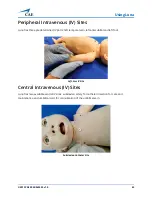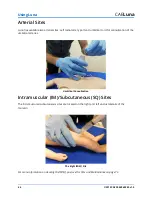
Luna Features
32
©2019 CAE 905K560252 v1.0
CAE
Luna
Physiological and Pharmacological Features
Luna presents patient reactions based on complex neurological, cardiovascular, and respiratory
models. The manikin allows for the physical assessment of various clinical signs (i.e., heart and
breath sounds, palpable pulses, chest excursion, airway patency, etc.) that are dynamically coupled
with the mathematical models of human physiology and pharmacology.
Neurologic System
Luna is equipped with a number of features specifically targeted to support training for neurological
care. The infant fontanel and pupil dilation stages can be used to simulate neurological conditions.
Fontanel:
A palpable anterior fontanel displays bulging, neutral and sunken conditions upon manual
filling. Using a pneumatic syringe assembly, the conditions can be manually adjusted.
Eyes:
The pupils can be adjusted independently to three levels of dilation: pinpoint, normal, blown.
Manual rotation of the eyes allow you to easily simulate any combination of balanced or anisocoric
dilation.
Skin tone colored patches are provided to insert over the pupil and underneath the head skin to
simulate closed eyes.
For more information, see
Using Luna
section of this user guide.
Respiratory System
Luna simulator represents a realistic Respiratory System to achieve an extremely accurate simulation
of respiration. This system is tightly integrated with the Cardiovascular System.
Cyanosis:
The Luna Advanced configuration manikin features circumoral cyanosis.
Respiratory System Features
The patient’s lungs simulate consumption of oxygen and the production of carbon dioxide in
accordance with the principles of uptake and distribution.
The lungs are realistically modeled with respect to the range of tidal volumes and functional
residual capacity.
Lung and chest wall compliance are modeled with independent control of the left and right lungs.
Spontaneous and mechanical modes of ventilation are supported.
Symmetric and asymmetric lung ventilation are automatically supported in response to bilateral
and unilateral compliance and resistance changes, proper or incorrect intubation, and
pathophysiological states such as tension pneumothorax. This capability can be accomplished
automatically without intervention of the instructor.



